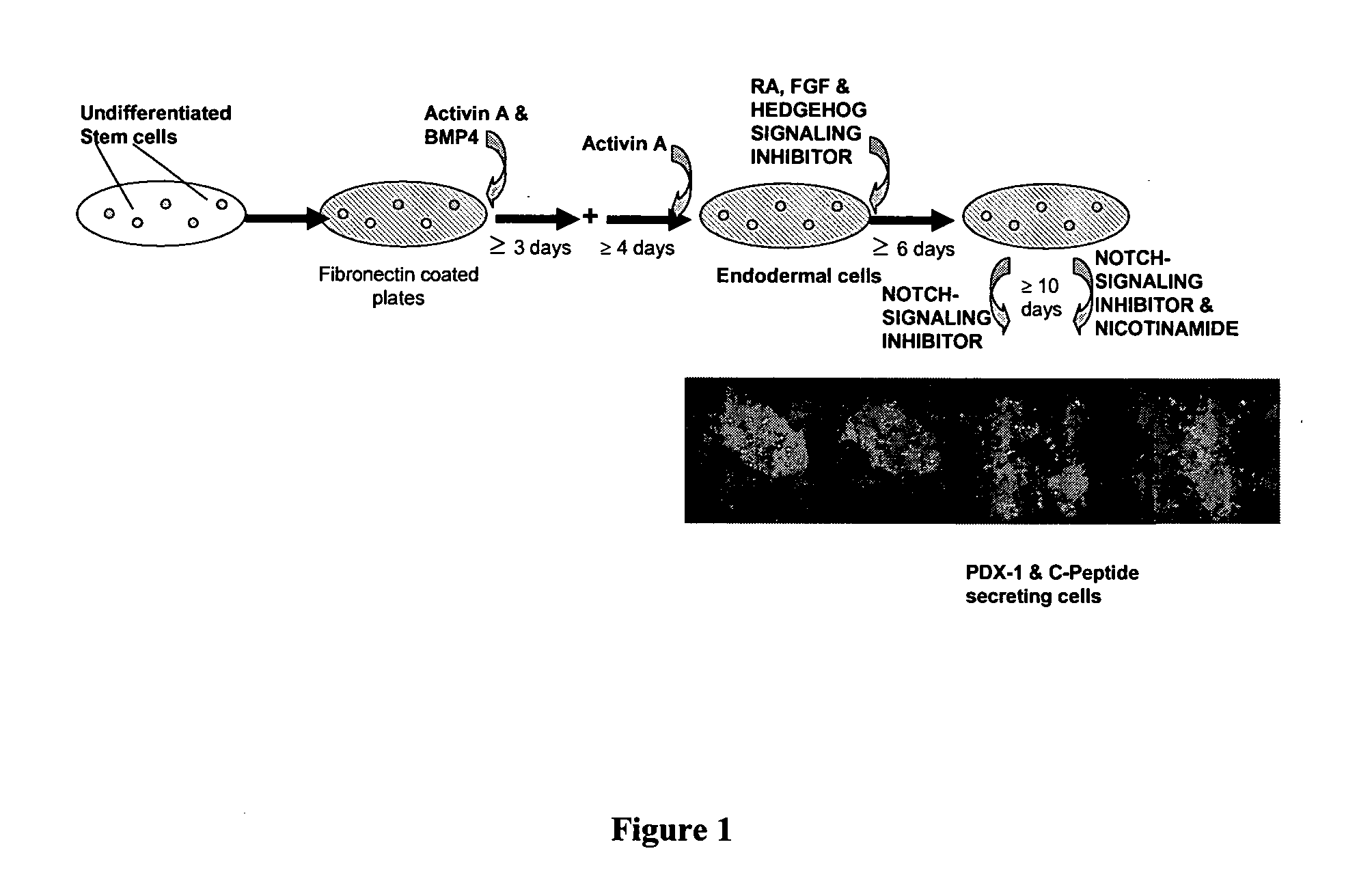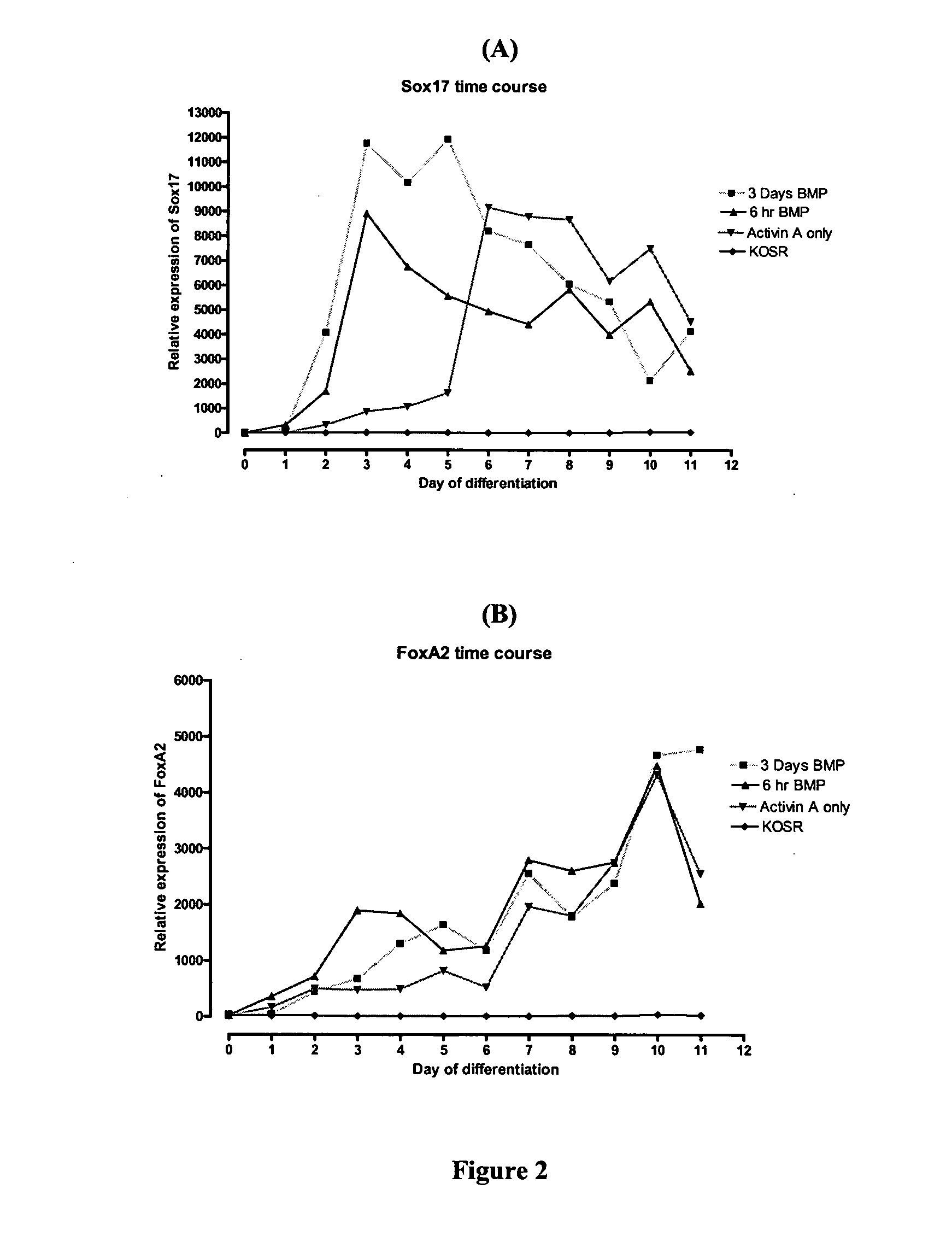Method of Differentiating Stem Cells
a stem cell and differentiation technology, applied in the field of stem cell differentiation, can solve the problems of reduced quality of life, accumulation in blood, and inability of body cells, and achieve the effect of improving the efficiency of differentiation of human embryonic stem cells
- Summary
- Abstract
- Description
- Claims
- Application Information
AI Technical Summary
Benefits of technology
Problems solved by technology
Method used
Image
Examples
example 1
Human Embryonic Stem Cell Culture
[0094]The human embryonic stem cell line HES-3 (http: / / www.nih.gov / ) was obtained from ES Cell International Pte Ltd (Singapore) and, representative human embryonic stem cell lines ESI035, ES1049 and ESI051 were used to confirm the results obtained from the HES-3 cell line. These cells were cultured on Ortec feeders in hESC medium consisting of KO-DMEM, 20% Knockout Serum Replacement (KOSR), 1×NEAA and 1×L-glutamine. Ortec feeders were obtained from ES Cell International Pte Ltd (Singapore). Ortec feeders were expanded in DMEM, 10% FBS and 1×L-glutamine. Feeders were irradiated to arrest cell division a plated onto gelatine-coated plates at 2×104 / cm2 overnight before the hES were plated on top of them. All culture reagents were obtained from Invitrogen. The cells were cultured at 37° C. in 5% CO2 in a humidified tissue culture incubator.
[0095]When confluent (approximately 7 days after plating), human embryonic stem cells were treated with 1 mg / ml col...
example 2
Formation of Definitive Endoderm
[0096]The effects of Activin A with and without BMP4 on the expression of markers of definitive endoderm were examined. Activin A and BMP4 were added to a mix of cell lines, ESI017 and ES1035, of Example 1 after the cells had been washed twice with PBS. Four groups of cells were then cultured in four different conditions:
1) 50 ng / ml Activin A and 50 ng / ml BMP4 in a culture medium (2% B-27, 1×Glutamax, 1×NEAA, 1×β-mercaptoethanol in RPMI 1640 (RPMI)) for 3 days followed by treatment with Activin A (50 ng / ml) in RPMI.
2) 50 ng / ml Activin A and 50 ng / ml BMP4 in RPMI for about 6 hours followed by treatment with Activin A (50 ng / ml) in RPMI.
3) 50 ng / ml Activin A in RPMI.
4) 10% KOSR in RPMI (negative control).
[0097]The cells were cultured continuously and a sample harvested daily. The medium was changed every 2-3 days. Real-time PCR was performed as described in Example 9. The results are shown in FIG. 2.
[0098]The combination of Activin A and BMP4 evoked a t...
example 3
[0099]In order to confirm the results of Example 2, a limited time-course experiment was performed using cells lines HES-3, ESI014, ESI017 and ESI035 from Example 1. Different groups of cells were then cultured in three different conditions:
1) 50 ng / ml Activin A and 50 ng / ml BMP4 in a culture medium (2% B-27, 1×Glutamax, 1×NEAA, 1×β-mercaptoethanol in RPMI 1640 (RPMI)) for 3 days followed by treatment with Activin A (50 ng / ml) in RPMI.
2) 50 ng / ml Activin A in RPMI.
3) 10% KOSR in RPMI (negative control).
[0100]The medium was changed every 2-3 days. RNA was extracted according to Example 2 on days 0, 3, 6, 10 and 12 of differentiation. This follow-up experiment showed that there is indeed a stronger induction of Sox17 when the cultures were pulsed with BMP4 (FIG. 3). There was an increase in the expression of Sox17 on days 3, 6, 10 and 12 when the cells were treated with BMP4 and Activin A compared to only Activin A. There was also an increase in the expression of FoxA2 on day 10 of di...
PUM
 Login to View More
Login to View More Abstract
Description
Claims
Application Information
 Login to View More
Login to View More - R&D
- Intellectual Property
- Life Sciences
- Materials
- Tech Scout
- Unparalleled Data Quality
- Higher Quality Content
- 60% Fewer Hallucinations
Browse by: Latest US Patents, China's latest patents, Technical Efficacy Thesaurus, Application Domain, Technology Topic, Popular Technical Reports.
© 2025 PatSnap. All rights reserved.Legal|Privacy policy|Modern Slavery Act Transparency Statement|Sitemap|About US| Contact US: help@patsnap.com



